#mobile prices in pakistan
Explore tagged Tumblr posts
Text
SAMSUNG Galaxy A06 5G Price | launched with 128GB Storage | know full Specifications & Features | Mobile Phone
SAMSUNG Galaxy A06 5G Price under $X9 | ₹XX,999 launched with 128GB Storage know full Specifications & Features. See here what are the prices of Galaxy A06 5G in different stores. SAMSUNG Galaxy A06 5G Price, Full Reviews/ Specifications GeneralDetailsBrandSAMSUNGModelSAMSUNG Galaxy A06 5GPrice$X9 | ₹XX,999 (Note:- See below to know the exact price)Release dateFeb 2025Form…
#Mobile#SAMSUNG Galaxy A06 5G#SAMSUNG Galaxy A06 price#SAMSUNG Galaxy A06 price in india#Samsung Galaxy A06 Price in Nigeria#SAMSUNG Galaxy A06 price in pakistan#Samsung Galaxy A06 Price in us#Samsung Galaxy A06 release date#Samsung Galaxy A06 review#Samsung Galaxy A06 specs#Samsung Galaxy A06s#tech news#Today Wold
2 notes
·
View notes
Text
0 notes
Text
Vivo Mobile Price in Pakistan: A Complete Guide

In recent years, Vivo has emerged as one of the most popular mobile brands in Pakistan. Known for its innovative features, stylish designs, and affordability, Vivo has captivated a large segment of the Pakistani market. As technology continues to evolve, Vivo offers a range of smartphones that cater to different needs and budgets. In this article, we will explore the latest Vivo mobile prices in Pakistan, highlight some of the most popular models, and discuss why this brand is a favorite among Pakistanis.
Vivo’s Impact on the Pakistani Mobile Market
Vivo entered the Pakistani market a few years ago and has since built a reputation for offering value-for-money smartphones. Competing with other major brands like Samsung, Huawei, and Xiaomi, Vivo Mobile Price in Pakistan has consistently provided phones with cutting-edge technology, impressive camera quality, and powerful performance. In a market where consumers are looking for budget-friendly yet high-performing devices, Vivo's success can be attributed to its ability to balance quality and cost.
Vivo Mobile Price in Pakistan: Current Range
As of 2024, Vivo offers a wide range of smartphones in Pakistan, from entry-level phones to high-end models. The price of Vivo mobiles in Pakistan can vary significantly depending on the model and its features. Entry-level phones such as the Vivo Y series are priced affordably, while the more premium models, like the Vivo V and X series, come with higher price tags due to their advanced features.
Popular Vivo Models and Their Prices in Pakistan

Vivo Y Series The Y series is Vivo's budget-friendly lineup and offers smartphones at affordable prices. The Vivo Y20, Y21, and Y33s are some of the popular models in this series. Prices for the Y series generally range from PKR 20,000 to PKR 35,000. These phones offer decent performance, good battery life, and are equipped with basic features, making them a great choice for students and budget-conscious buyers.
Vivo V Series The V series is Vivo’s mid-range offering and is aimed at users who want better features and performance than what the Y series provides. With models like the Vivo V23, V21, and V25e, the V series is known for its stylish design, powerful cameras, and fast processors. These phones are priced between PKR 50,000 to PKR 80,000, making them suitable for those who want premium features without breaking the bank.
Vivo X Series The Vivo X series is the brand’s flagship lineup and offers the latest innovations and highest specifications. Models like the Vivo X70 and X80 Pro feature advanced camera technology, top-of-the-line processors, and premium design. Prices for the X series start from around PKR 100,000 and can go up to PKR 150,000 or more, depending on the specific model.
Factors Influencing Vivo Mobile Prices in Pakistan

The price of a Vivo mobile in Pakistan is influenced by several factors, including the model, its features, and market demand. Here are some of the primary aspects that impact the price:
Camera Technology Vivo is known for its camera innovations, particularly in its high-end models. Features like AI-enhanced photography, night mode, and professional-grade lenses drive up the price of Vivo smartphones. Models in the V and X series come with advanced camera systems, which make them more expensive compared to the Y series.
Processor and Performance High-performance processors, more RAM, and better GPU support generally lead to higher prices. While the entry-level Y series offers decent performance for everyday tasks, the V and X series are powered by faster processors like the Qualcomm Snapdragon or MediaTek chips, making them more suitable for gaming and multitasking.
Battery Life Battery life is a crucial factor for many users in Pakistan, where reliable access to charging can sometimes be limited. Vivo phones typically come with large batteries and fast-charging capabilities, which add to the phone's overall value and cost.
Display Technology The display quality and screen size are also major factors affecting the price. Vivo’s flagship models feature AMOLED displays with high refresh rates, providing a smoother and more vivid viewing experience. This technology is more expensive and, therefore, reflects in the pricing of premium models like the X and V series.
Storage and Memory Storage capacity and RAM are other factors that contribute to a smartphone’s price. Vivo smartphones come with various configurations, offering more storage and memory at higher price points. Phones with 128GB or 256GB of storage, combined with 8GB or 12GB of RAM, tend to be priced higher than models with lower storage and memory options.
Why Vivo is Popular in Pakistan
There are several reasons behind Vivo's popularity in Pakistan, ranging from its pricing strategy to its understanding of local market needs.
Affordability Vivo provides smartphones that cater to a wide range of consumers, from those looking for affordable devices to those seeking high-end features. This flexibility in pricing has helped the brand capture a diverse audience.
Quality Features Whether it’s the camera, battery, or overall performance, Vivo ensures that even its budget-friendly models are packed with quality features. This focus on delivering value has earned Vivo a loyal customer base in Pakistan.
Frequent Model Updates Vivo frequently introduces new models, ensuring that it remains competitive in the fast-evolving smartphone market. With regular software updates and new product releases, the brand keeps consumers engaged and loyal.
Conclusion:
The price of Vivo mobiles in Pakistan varies based on the model, features, and specifications. From the budget-friendly Y series to the premium X series, Vivo offers smartphones for everyone. Whether you are a student looking for an affordable device or a tech enthusiast wanting the latest features, Vivo has something for you.
By understanding the factors that influence the price, such as camera technology, battery life, and processing power, you can make an informed decision about which Vivo model best suits your needs and budget.
FAQs
What is the price range of Vivo mobiles in Pakistan? Vivo mobiles in Pakistan range from around PKR 20,000 for entry-level models like the Y series to over PKR 150,000 for flagship models like the X series.
Which Vivo model is best for gaming in Pakistan? The Vivo X and V series are ideal for gaming, as they come with powerful processors, ample RAM, and enhanced graphics capabilities. Models like the Vivo X80 Pro offer an excellent gaming experience.
0 notes
Text
Samsung tablet price in Pakistan
Get the best Samsung tablet price in Pakistan at Lahore Centre. Mobile phones are available at affordable prices here
0 notes
Link
https://gadgetsinfo.tech/2023/06/26/blackberry-key2-le/
0 notes
Text
POCO F4 GT 5G - Smartphone 12+256GB, Full Specifications
Poco F4 Gt 5g Full Specifications and detail

View On WordPress
#Blogging#gaming mobiles#mobile specifications#mobiles#poco f4 gt 5g#poco f4 gt price in pakistan#poco f4 gt price in pakistan whatmobile#Postaday#specifications#TopMobiles
1 note
·
View note
Text
Tuesday, October 15, 2024
Florida neighbors band together to recover (AP) When ankle-deep floodwaters from Hurricane Helene bubbled up through the floors of their home, Kat Robinson-Malone and her husband sent a late-night text message to their neighbors two doors down: “Hey, we’re coming.” The couple waded through the flooded street to the elevated front porch of Chris and Kara Sundar, whose home was built on higher ground, and handed over their 8-year-old daughter and a gas-powered generator. The Sundars’ lime-green house in southern Tampa also became a refuge for Brooke and Adam Carstensen, whose house next door to Robinson-Malone also flooded. The three families met years earlier when their children became playmates, and the adults’ friendships deepened during the coronavirus pandemic in 2020. So when Helene and Hurricane Milton struck Florida within two weeks of each other, the neighbors closed ranks as one big extended family, cooking meals together, taking turns watching children and cleaning out their damaged homes. “Everyone has, like, the chain saw or a tarp,” Robinson-Malone said Sunday. “But really the most important thing for us was the community we built. And that made all the difference for the hurricane rescue and the recovery. And now, hopefully, the restoration.”
Thousands march in Spain to demand affordable housing (Reuters) Thousands protested on Sunday in Madrid to demand more affordable housing amid rising anger from Spaniards who feel they are being priced out of the market. “Spaniards cannot live in their own cities. They are forcing us out of the cities,” said nurse Blanca Prieto, 33. Spain is struggling to balance promoting tourism, a key driver of its economy, and addressing citizens’ concerns over unaffordable high rents due to gentrification and landlords shifting to more lucrative tourist rentals. Residents of the Canary Islands and Malaga have also staged protests this year against the rise in tourist rentals. Seasonal hospitality workers struggle to find accommodation in these tourism hot spots, with many resorting to sleeping in caravans or even their cars.
Russian Strikes on Ukrainian Ports Target Shipping (NYT) Russia has stepped up its assaults on Black Sea port infrastructure and civilian shipping in recent days, in what Ukraine says is an attempt to disrupt its exports and damage its economy. The attacks are part of an intensifying campaign of strikes on the city of Odesa and the region along Ukraine’s southern coast. Since last Monday, Russia has carried out five attacks in the area, killing 14 civilians and injuring 28, the U.N.’s Human Rights Monitoring Mission in Ukraine reported on Friday, citing local authorities. The strikes on ships were mostly aimed at those flying flags of small countries unlikely to retaliate against Russia. Last Monday, a container ship under the flag of Palau was hit, Ukrainian official said. The day before that, a missile damaged a vessel under a Saint Kitts and Nevis flag, according to the regional military administration.
Pakistan’s internet slows to a crawl as blame falls on government (Washington Post) Mobile internet in Pakistan has been painfully slow for over two months. Now, technology experts and political activists are accusing the government of intentionally throttling the internet to suppress political protesters. Digital rights activists fear that Pakistani officials are installing new controls to more tightly monitor social media and to censor political content.
China’s ‘New Great Wall’ Casts a Shadow on Nepal (NYT) The Chinese fence traces a furrow in the Himalayas, its barbed wire and concrete ramparts separating Tibet from Nepal. Here, in one of the more isolated places on earth, China’s security cameras keep watch alongside armed sentries in guard towers. High on the Tibetan Plateau, the Chinese have carved a 600-feet-long message on a hillside: “Long live the Chinese Communist Party,” inscribed in characters that can be read from orbit. Just across the border, in Nepal’s Humla District, residents contend that along several points of this distant frontier, China is encroaching on Nepali territory. The Nepalis have other complaints, too. Chinese security forces are pressuring ethnic Tibetan Nepalis not to display images of the Dalai Lama, the exiled Tibetan spiritual leader, in Nepali villages near the border, they say. “This is the new Great Wall of China,” said Jeevan Bahadur Shahi, the former provincial chief minister of the area. China’s fencing along the edge of Nepal’s Humla District is just one segment of a fortification network thousands of miles long that Xi Jinping’s government has built to reinforce remote reaches, control rebellious populations and, in some cases, push into territory that other nations consider their own.
Sri Lanka closes schools as floods hammer the capital (AP) Sri Lanka closed schools in the capital Colombo and suburbs on Monday as heavy rains triggered floods in many parts of the island nation. Heavy downpours over the weekend have wreaked havoc in many parts of the country, flooding homes, fields and roads. Three people drowned, while some 134,000 people have been affected by flooding, according to the country’s Disaster Management Centre. Sri Lanka has been grappling with severe weather conditions since May, mostly caused by heavy monsoon rains. In June, 16 people died due to floods and mudslides.
Can the Government Get People to Have More Babies? (NYT) In 1989, Japan seemed to be an unstoppable economic superpower. Its companies were overtaking competitors and gobbling up American icons like Rockefeller Center. But inside the country, the government had identified a looming, slow-motion crisis: The fertility rate had fallen to a record low. Policymakers called it the “1.57 shock,” citing the projected average number of children that women would have over their childbearing years. If births continued to decline, they warned, the consequences would be disastrous. Taxes would rise or social security coffers would shrink. Japanese children would lack sufficient peer interaction. Society would lose its vitality as the supply of young workers dwindled. It was time to act. Starting in the 1990s, Japan began rolling out policies and pronouncements designed to spur people to have more babies. The government required employers to offer child care leave of up to a year, opened more subsidized day care slots, exhorted men to do housework and take paternity leave, and called on companies to shorten work hours. In 1992, the government started paying direct cash allowances for having even one child (earlier, they had started with the third child), and bimonthly payments for all children were later introduced. None of this has worked. Last year, Japan’s fertility rate stood at 1.2. In Tokyo, the rate is now less than one. The number of babies born in Japan last year fell to the lowest level since the government started collecting statistics in 1899. Now the rest of the developed world is looking more and more like Japan.
The Brewing War With Israel Is Boosting Iran’s Young Hard-Liners (Foreign Affairs) The Islamic Revolutionary Guard Corps, Iranian Supreme Leader Ali Khamenei’s influential, ideological armed force, has been riven by divisions between its older, conservative commanders and its younger, radical ranks. The former generally favor exercising some restraint when it comes to Israel, whereas the latter want to go directly after the Islamic Republic’s nemesis. Typically, the older elite have held more influence with the supreme leader. But as more and more IRGC commanders and partners have been killed, the younger generations have gained the upper hand. They have done so by questioning the competence of their elders but also by suggesting that some IRGC elites are actually Israeli assets, including Esmail Ghaani, the IRGC commander who controls Iran’s Quds force—which, in turn, controls Iran’s network of proxy militias. After Israel killed Nasrallah, Khamenei’s calculus appears to have been shaped by this younger cohort. It is part of why Khamenei launched the October 1 attack.
Netanyahu Is Killing Us To Set Us Free? Logic, Grief And Resistance In Beirut (Daraj/Lebanon) Israeli Prime Minister Benjamin Netanyahu addressed us, the Lebanese people, and offered us a gift: a massacre. He sent soldiers to the Lebanese border town of Maroun al-Ras, raised an Israeli flag there, and sent the picture to the whole world. Netanyahu, who has so far killed more than 40,000 Palestinians and about 3,000 Lebanese, addressed us directly—and said that he is killing us for the sake of our future [by destroying Hezbollah]. Netanyahu tells us that he wants to give us after killing us, a homeland, one that is no more than a graveyard and no less than a colony. This speech he addressed to us is truly amazing, a summary of what awaits us if Netanyahu, owner of the “massacre doctrine,” achieves what he wants.
U.S. to Deploy Missile Defense System and About 100 Troops to Israel (NYT) The United States is sending an advanced missile defense system to Israel, along with about 100 American troops to operate it, the Pentagon announced on Sunday. The move will put American troops operating the ground-based interceptor, which is designed to defend against ballistic missiles, closer to the widening war in the Middle East. It comes after Iran launched about 200 missiles at Israel on Oct. 1 and as Israel plans its retaliatory attack. The THAAD battery, a mobile defense system, will give the Israel Defense Forces another layer of protection to defend cities, troops and installations from short- and intermediate-range ballistic missiles like those deployed by Iran in its last attack.
Netanyahu tells U.S. that Israel will strike Iranian military, not nuclear or oil, targets, officials say (Washington Post) Israeli Prime Minister Benjamin Netanyahu has told the Biden administration he is willing to strike military rather than oil or nuclear facilities in Iran, according to two officials familiar with the matter, suggesting a more limited counterstrike aimed at preventing a full-scale war. In the two weeks since Iran’s latest missile barrage on Israel, its second direct attack in six months, the Middle East has braced for Israel’s promised response, fearing the two countries’ decades-long shadow war could explode into a head-on military confrontation. It comes at a politically fraught time for Washington, less than a month before the election, and President Joe Biden has said publicly he would not support an Israeli strike on nuclear-related sites. When Biden and Netanyahu spoke Wednesday—their first call in more than seven weeks after months of rising tensions between the two men—the prime minister said he was planning to target military infrastructure in Iran, according to a U.S. official and an official familiar with the matter.
Is Israel deploying a ‘surrender or starve’ strategy in Gaza? (Washington Post) Northern Gaza, already pummeled by a year of ruinous war, is in the grips of a punishing new Israeli offensive. Israeli forces encircled the battered Jabalya refugee camp in a bid to “systematically dismantle terrorist infrastructure,” according to an IDF statement. Israel issued evacuation orders to some 400,000 remaining residents in northern Gaza, telling them to go to areas farther south that are already teeming with the displaced and still hit by Israeli bombardments. Airstrikes have killed dozens. Aid workers described a catastrophic scene. “It is like hell to be honest,” Fares Afana, the head of ambulance services in northern Gaza, told The Washington Post in a voice note on Sunday. Israeli forces were attacking the Jabalya refugee camp “for the third time and its surroundings in Beit Lahya and Beit Hanoun,” Afana said, and the camp was surrounded “from all sides.” Humanitarian organization Doctors Without Borders said Friday that thousands of people—including five of its staffers—were trapped in the Jabalya camp. “Nobody is allowed to get in or out—anyone who tries is getting shot,” Sarah Vuylsteke, a project coordinator for the organization, said in a news release. The intensifying siege will “continue as long as required in order to achieve its objectives,” the IDF said in a statement. It comes alongside an apparent blockade. No food trucks have entered at all in October. Such a tactic may fuel further accusations that Israel is deliberately starving Palestinians in Gaza.
2 notes
·
View notes
Text
Exclusive: Imran Khan on His Plan to Return to Power
— By Charlie Campbell | April 3, 2023 | Time Magazine
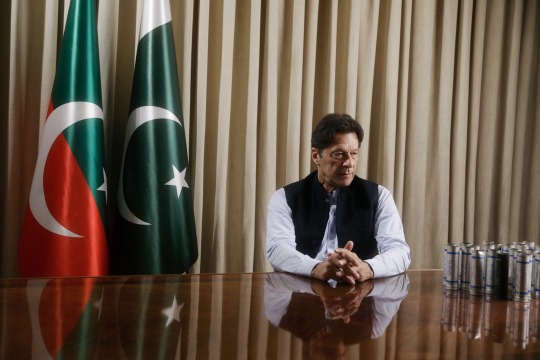
Former Pakistan Prime Minister Imran Khan sits for a portrait in his Lahore residence on March 28. Next to Khan are tear gas canisters he says were thrown at his house. Umar Nadeem for Time Magazine
Political leaders often boast of inner steel. Imran Khan can point to three bullets dug out of his right leg. It was in November that a lone gunman opened fire on Khan during a rally, wounding the 70-year-old as well as several supporters, one fatally. “One bullet damaged a nerve so my foot is still recovering,” says the former Pakistani Prime Minister and onetime cricket icon. “I have a problem walking for too long.”
If the wound has slowed Khan, he doesn’t show it in a late-March Zoom interview. There is the same bushy mane, the easy laugh, prayer beads wrapped nonchalantly around his left wrist. But in the five years since our last conversation, something has changed. Power—or perhaps its forfeiture—has left its imprint. Following his ouster in a parliamentary no-confidence vote in April 2022, Khan has mobilized his diehard support base in a “jihad,” as he puts it, to demand snap elections, claiming he was unfairly toppled by a U.S.-sponsored plot. (The State Department has denied the allegations.)
The actual intrigue is purely Pakistani. Khan lost the backing of the country’s all-powerful military after he refused to endorse its choice to lead Pakistan’s intelligence services, known as ISI, because of his close relationship with the incumbent. When Khan belatedly greenlighted the new chief, the opposition sensed weakness and pounced with the no-confidence vote. Khan then took his outrage to the streets, with rallies crisscrossing the nation for months.

Photograph by Umar Nadeem for Time Magazine
“Imran Khan can communicate with all strata of society on their level,” says Shaheena Bhatti, 63, a professor of literature in Rawalpindi. “The other politicians are … not going to do anything for the country because they’re only in it for themselves.”
The November attack on Khan’s life only intensified the burning sense of injustice in members of his Pakistan Tehreek-e-Insaf party, or PTI, who have since clashed with police in escalating street battles involving slingshots and tear gas. Although an avowed religious fanatic was arrested for the shooting, Khan continues to accuse an assortment of rival politicians of pulling the strings: incumbent Prime Minister Shehbaz Sharif—brother of Khan’s longtime nemesis, former Prime Minister Nawaz Sharif—as well as Interior Minister Rana Sanaullah and Major General Faisal Naseer. (All have denied the accusation.)
In addition to bullets, Khan has also been hit by charges—143 over the past 11 months, by his count, including corruption, sedition, blasphemy, and terrorism—which he claims have been concocted in an attempt to disqualify him from politics. After Sharif’s cabinet declared on March 20 that the PTI was “a gang of militants” whose “enmity against the state” could not be tolerated, police arrested hundreds of Khan supporters in raids.
“Either Imran Khan exists or we do,” Interior Minister Sanaullah said on March 26.
Pakistan sometimes seems to reside on a precipice. Its current political instability comes amid devastating floods, runaway inflation, and resurgent cross-border terrorist attacks from neighboring Afghanistan that together threaten the fabric of the nation of 230 million. It’s a country where rape and corruption are rife, and the economy hinges on unlocking a stalled IMF bailout, Pakistan’s 22nd since independence in 1947. Inflation soared in March to 47% year-over-year; the prices of staples such as onions rose by 228%, wheat by 120%, and cooking gas by 108%. Over the same period, the rupee has plummeted by 54%.
“Ten years ago, I earned 10,000 rupees a month [$100] and I wasn’t distressed,” says Muhammad Ghazanfer, a groundsman and gardener in Rawalpindi. “With this present wave of inflation, even though I now earn 25,000 [$90 today] I can’t make ends meet.” The world’s fifth most populous country has only $4.6 billion in foreign reserves—$20 per citizen. “If they default, and they can’t get oil, companies go bust, and people don’t have jobs, you would say this is a country ripe for a Bolshevik revolution,” says Cameron Munter, a former U.S. ambassador to Pakistan.
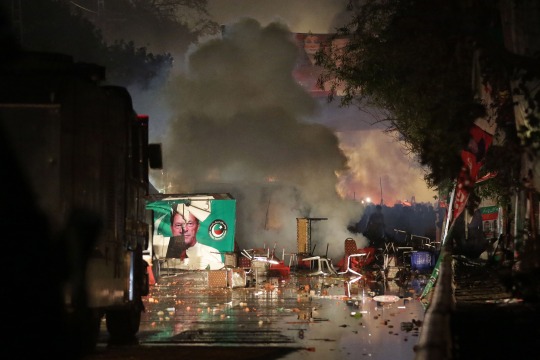
Police fired teargas to disperse the supporters of the former Prime Minister as they tried to arrest Khan in Lahore, Pakistan, on March 14. Hundreds of Tehrik-e-Insaf supporters clashed with riot police as they reached Khan's residence. Rahat Dar—EPA-EFE/Shutterstock
“Our economy has gone into a tailspin,” says Khan. “We now have the worst economic indicators in our history.” The situation threatens to send the nuclear-armed country deeper into China’s orbit. Yet sympathy is slim in a West put off by Khan’s years of anti-American bluster and cozying up to autocrats and extremists, including the Taliban. He calls autocratic Turkish President Recep Tayyip Erdogan “my brother” and visited Russian President Vladimir Putin in Moscow on the eve of the Ukraine invasion, remarking on “so much excitement.” Khan can both repeatedly declare Osama bin Laden a “martyr” and praise Beijing’s confinement of China’s Uighur Muslim minority. He has obsessed on Joe Biden’s failure to call him after entering the White House. “He’s someone that is imbued with this incredibly strong sense of grievance,” says Michael Kugelman, the deputy director of the Asia Program at the Woodrow Wilson Center.
Yet Khan can legitimately claim to have democracy on his side, with poll numbers suggesting he is a shoo-in to return to power if the elections he demands happen. “His popularity has skyrocketed,” says Samina Yasmeen, director of the Centre for Muslim States and Societies at the University of Western Australia. “No matter what he says, even if it’s irrational, the reality is that people are angry and taken by his message.”
“Imran Khan is the best bet we have right now,” says Osama Rehman, 50, a telecommunications engineer in Islamabad. “If [he] is arrested or disqualified, people will come out onto the street.”
The state appears to flirt with the idea. Police raids on Khan’s home in the Punjab province capital of Lahore in early March left him choking on tear gas, he says, as supporters brandishing sticks battled police in riot gear before makeshift barricades of sandbags and iron rods. “This sort of crackdown has never taken place in Pakistan,” says Khan. “I don’t know even if it was as bad under martial law.”
After Khan left his compound to appear in court on March 18, traveling in an armored SUV strewn with flower petals and flanked by bodyguards, the police swooped in while his wife was home, he says, beating up servants and hauling the family cook off to jail. He claims another assassination attempt awaited inside the Islamabad Judicial Complex, which was “taken over by the intelligence agencies and paramilitary.”
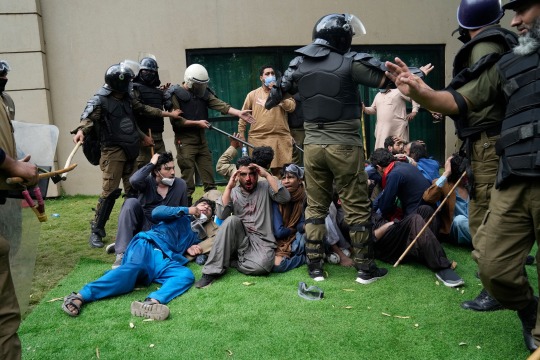
Police arrested 61 supporters of former Prime Minister Imran Khan during a search operation near Khan’s residence, in Lahore, Pakistan, on March 18, 2023. K.M. Chaudary—AP
The confrontation could remain in the streets indefinitely. Prime Minister Sharif has rejected Khan’s demand for a snap election, saying polls would be held as scheduled in the fall. But “every narrative is being built up [for the government] to justify postponing the elections,” says Yasmeen. On March 22, Pakistan’s Election Commission delayed local balloting in Punjab, the country’s most populous province, from April 30 until Oct. 8.
“Political stability in Pakistan comes through elections,” Khan points out. “That is the starting point for economic recovery.” From the U.S. perspective, he may be far from the ideal choice to helm an impoverished, insurgency-racked Islamic state. But is he the only person that can hold the country together?
“Never has one man scared the establishment … as much as right now,” says Khan. “They worry about how to keep me out; the people how to get me back in.”
It’s indicative of Pakistan’s malaise that its most popular politician in decades sits barricaded at home. But the nation has always been beyond comparison—a wedge of South Asia that begins in the shimmering Arabian Gulf and ascends to its Himalayan heights. It’s the world’s largest Islamic state, though governed for half its history by men in olive-green uniforms, who continue to act as ultimate arbiters of power.
The only boy of five children, Khan was born Oct. 5, 1952 to an affluent Pashtun family in Lahore. He studied politics, philosophy, and economics at Oxford University, and it was in the U.K. that he first played cricket for Pakistan, at age 18. Britain’s sodden terrain also provided the backdrop to his political awakening.
“When I arrived in England our country had been ruled by a military dictator for 10 years; the powerful had one law, the others were basically not free human beings,” he says. “Rule of law actually liberates human beings, liberates potential. This was what I discovered.”
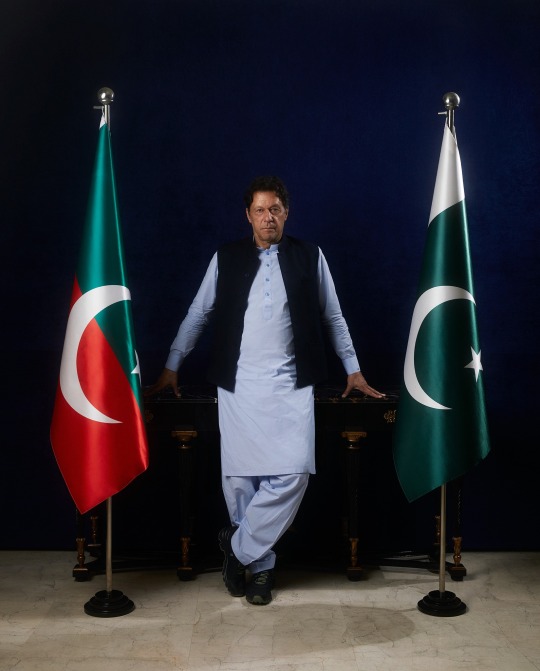
Khan in his Lahore residence on March 28. Umar Nadeem for Time Magazine
On the cricket pitch, Khan was a talisman who knitted together mercurial talents and journeymen into a cohesive whole, a team that overcame extraordinary odds to famously lift the Cricket World Cup in 1992. There were glimpses of these qualities when Khan rose to become Prime Minister: running on an anti-graft ticket, he fused a disparate band of students and workers, Islamic hard-liners, and the nation’s powerful military to derail the Sharif political juggernaut. His crowning achievement remains the Shaukat Khanum Cancer Hospital in Lahore, which he opened in 1994 in memory of his mother, who succumbed to the disease. It is the largest cancer hospital serving Pakistan’s impoverished, boosting Khan’s administrative credentials.
Khan spent 22 years in the political wilderness before his 2018 election triumph. But once in power, the self-styled bold reformer turned unnervingly divisive. Opposition is easier than government, and Khan found himself bereft of ideas and besieged by unsavory partners, even kowtowing to the now-banned far-right party Tehreek-e-Labbaik Pakistan despite its support for the extrajudicial killing of alleged blasphemers. There were some successes: Pakistan received praise for its handling of the pandemic, with deaths per capita just a third that of neighboring India. His “Ten Billion Tree Tsunami” reforestation drive was popular, as was the 2019 return of international test cricket, the most prestigious form of the game, following a terrorist attack on the Sri Lankan team and a decade-long hiatus.
Khan’s private life has rarely been out of the headlines. His first wife was British journalist and society heiress Jemima Khan, née Goldsmith, a close friend of Diana, Princess of Wales. She converted to Islam for their wedding, though the pair divorced in 2004 after nine years of marriage, and her family’s Jewish heritage was political dynamite. (The couple’s two sons live in London.) Khan’s second marriage to British-Pakistani journalist Reham Khan lasted nine months. According to a 1997 California court ruling, Khan also has one child, a daughter, born out of wedlock, and he’s struggled to quash gossip of several more. In 2018, six months before he took office, he married his current wife, Bushra Bibi Khan, a religious conservative who is believed to be the only Pakistan First Lady to wear the full-face niqab shawl in public.
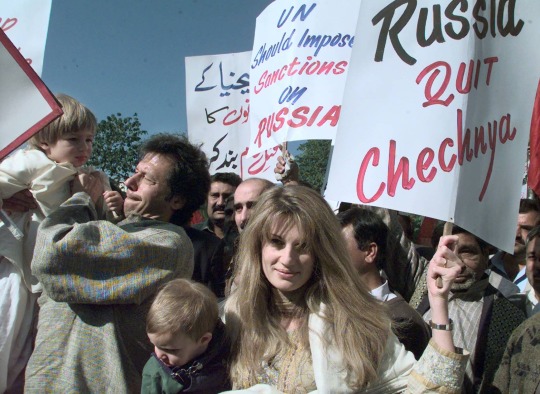
Khan, left, lifts elder son Suleman while his ex-wife Jemima carries younger son Qasim during a march towards the U.N. offices in Islamabad in 1999. The Khans led some 100 demonstrators in an anti-Russian rally protesting against attacks in Chechnya. Reuters
It all fed Khan’s legend: the debonair playboy who grew devout; the privileged son who rails against the corrupt; the humanist who stands with the bloodthirsty. His youth was spent carousing with supermodels in London’s trendiest nightspots. But his politics has hardened as his handsome features have lined and leathered. He provoked outrage when in August 2021 he said the Taliban had “broken the shackles of slavery” by taking back power (he insists to TIME he was “taken out of context”) and has made various comments criticized as misogynistic. When asked about the drivers of sexual violence in Pakistan, he said, “If a woman is wearing very few clothes, it will have an impact on the men, unless they’re robots.” Khan has refused to condemn Putin’s invasion, insisting, like China, on remaining “neutral” and deflecting uncomfortable questions onto supposed double standards regarding India’s inroads into disputed Kashmir. “Morality in foreign policy is reserved for powerful countries,” he says with a shrug.
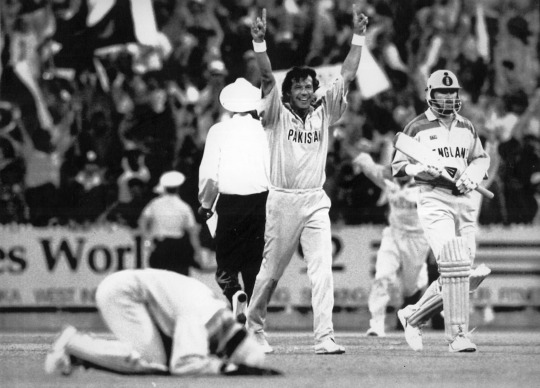
Khan in the 1992 Cricket World Cup. Pakistan won under Khan's captaincy this year. Fairfax Media
At the same time, Khan’s ideological flexibility has not stretched to compromises with opponents. He claims it was the military’s unwillingness to go after Pakistan’s influential “two families”—those of Sharif and the Bhutto clan of former Prime Ministers Zulfikar and Benazir—for alleged corruption that caused his relationship with the generals to fray. “If the ruling elite plunders your country and siphons off money, and you cannot hold them accountable, then that means there is no rule of law,” he says.
Yet analysts say that it was Khan’s relentless taunting of the U.S. that torpedoed his relationship with the military, which remains much more interested in retaining good relations with Washington. To journalists and supporters, he has accused the U.S. of imposing a “master-slave” relationship on Pakistan and of using it like “tissue paper.” To TIME, he insists that “criticizing U.S. foreign policy does not make you anti-American.” Still, by 2022, the generals no longer had his back. The common perception among Pakistan watchers is that Khan’s fleeting political success was owed to a Faustian pact with the nation’s military and extremist groups that shepherded his election victory and he is now reaping the whirlwind.
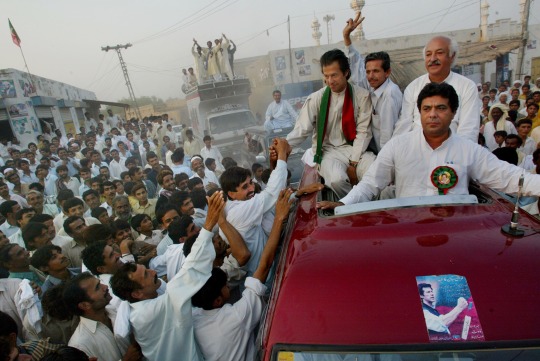
Cricket captain turned politician Imran Khan shakes hands with supporters during a rally in October 2002 in Shadi Khal, Pakistan. Paula Bronstein—Getty Images
He appears to relish in the perceived injustice, the walls closing in. On March 25, Khan addressed thousands of supporters in central Lahore from a bulletproof box above a green-and-red flag with the initials of his PTI emblazoned on a cricket bat—once Khan’s weapon of choice, though now he wields words with similar potency.
“I know you have decided you wouldn’t allow Imran Khan back in power,” he said. “That’s fine with me. But do you have a plan or know how to get the country out of the current crisis?”
If Pakistan’s economic woes are reaching a new nadir, the trajectory was established during Khan’s term. A revolving door of Finance Ministers was compounded by bowing to hardliners. (After appointing renowned Princeton economist Atif Mian as an adviser, Khan fired him just days later owing to a backlash from Islamists because Mian is an Ahmadi, a sect of Islam they consider heretics.) In 2018, Khan pledged not to follow previous administrations’ “begging bowl” tactics of foreign borrowing, in order to end Pakistan’s cycle of debt. But less than a year later, he struck a deal with the IMF to cut social and development spending while raising taxes in exchange for a $6 billion loan. Mismanagement exacerbated global headwinds from the pandemic and soaring oil prices.
Meanwhile, little was done to address Pakistan’s fundamental structural issues: few people pay tax, least of all the feudal landowners who control traditional low-added-value industries like sugar farms, textile mills, and agricultural interests while wielding huge political-patronage networks stemming from their workers’ votes. In 2021, only 2.5 million Pakistanis filed tax returns—less than 1% of the adult population. “People don’t pay tax, especially the rich elite,” says Khan. “They just siphon out money and launder it abroad.”
Instead, Pakistan has relied on foreign money to balance a budget and provide government services. The U.S. funneled nearly $78.3 billion to Pakistan from 1948 to 2016. But in 2018, President Trump ended the $300 million security assistance that the U.S. provided annually. Now Pakistan must shop around for new benefactors—chiefly Saudi Arabia, Russia, and China. When Khan visited Putin last February, it was to arrange cheap oil and wheat imports and discuss the $2.5 billion Pakistan Stream gas pipeline, which Moscow wants to build between Karachi and Kasur. More recently, China has stepped in. In early March, the Industrial and Commercial Bank of China approved a $1.3 billion loan rollover—a fiscal bandaid for a gaping wound.
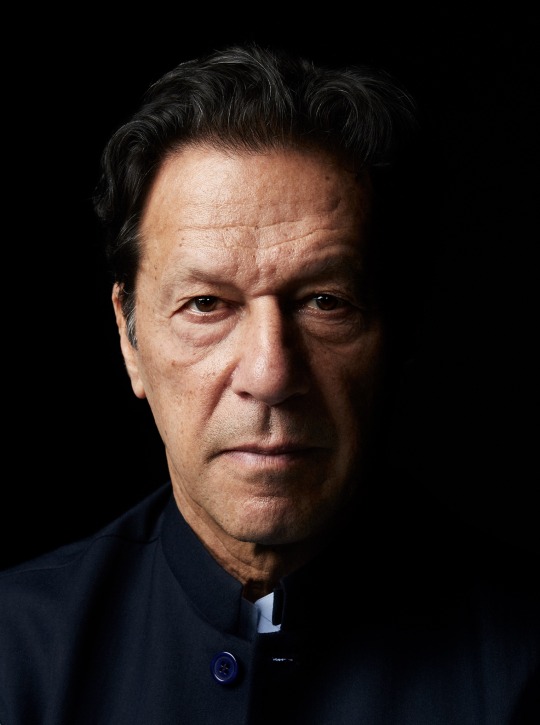
Khan in his Lahore residence on March 28. Umar Nadeem for Time Magazine
But if Khan recognized the problem, he did little to solve it. After his election in 2018, he was in an uncommonly strong position with the backing of the military and progressives, as well as the tolerance of the Islamists. Now, with all the bad blood and open warfare among these factions, even if he claws his way back, “he’ll be in a weaker position to actually effect any reforms,” says Munter, the former U.S. ambassador, “if he had any reforms to begin with.”
When asked for his step-by-step plan to get Pakistan back on track, Khan is light on details. After elections, he says that a “completely new social contract” is required to enshrine power in political institutions, rather than the military. If the army chief “didn’t think corruption was that big a deal, then nothing happened,” Khan complains. “I was helpless.” But the path to this utopia remains murky. Asked how he plans to turn his much trumpeted Islamic Welfare State ideal into a reality, Khan talks about Medina under the Prophet and the social conscience of Northern Europeans. “Scandinavia is probably far closer to the Islamic ideal than any of the Muslim countries.”
But the military looms large in Pakistan partly because national security is a perennial issue. Many assumed that the newly returned Taliban would stamp out all cross-border attacks from Afghanistan. But Pakistan recorded the second largest increase in terrorism-related deaths worldwide in 2022, up 120% year-over-year. “It was Khan who was pushing for talks with [the Taliban] at all costs,” says Kugelman, of the Woodrow Wilson Center. “That embrace is now experiencing significant levels of blowback.”
That Pakistan is moving away from the U.S. and closer to Russia and China is a moot point; the bigger question is who actually wins from embracing Pakistan. The $65 billion China-Pakistan Economic Corridor was supposed to be the crown jewel in President Xi Jinping’s signature Belt and Road Initiative, linking China via roads, rail and pipeline to the Arabian Sea. But Gwadar Port is rusting and suicide bombers are taking aim at buses filled with Chinese workers. Loans are more regularly defaulted than paid. Today, even Iran looks like a more stable partner.
Ultimately, competition with Beijing defines American foreign policy today, meaning Washington prioritizes relations with Pakistan’s archnemesis India, which is a key partner in the Biden Administration’s Indo-Pacific Strategy to contain China. Toward that imperative, the White House turns a blind eye even to New Delhi’s continued close relationship with Putin. The U.S. kinship with India may mean Pakistan was always destined to move closer to China. But after the U.S. pulled out of Afghanistan, Pakistan is not the strategic lynchpin it once claimed to be—and memories are hardly fond; Pakistan secretly invested heavily in the Taliban. “Lots of Americans in Washington say we lost the war in Afghanistan because the Pakistanis stabbed us in the back,” says Munter.
What happens next? Many in Khan’s PTI suspect the current government may declare their party a terrorist organization or otherwise ban it from politics. Others believe that Pakistan’s escalating economic, political, and security turmoil may be used as grounds to postpone October’s general election. Ultimately, all sides are using the tools at their disposal to prevent their own demise: Khan wields popular protest and the banner of democracy; the government has the courts and security apparatus. Caught between the two, the people flounder. “There are no heroes here,” says Kugelman. “The entire political class and the military are to blame for the very troubled state the country finds itself in now.”
It’s a crisis that Khan still claims can be solved by elections, despite his broken relationship with the military. “The same people who tried to kill me are still sitting in power,” he says. “And they are petrified that if I got back [in] they would be held accountable. So they’re more dangerous.”
—With reporting by Hasan Ali/Islamabad
2 notes
·
View notes
Text
Vivo V40 Lite Price | launched with 12GB RAM | know full Specifications & Features | Mobile Phone
Nokia G500 5G Price under $3X2 | ₹3X,X00 launched with 12GB RAM know full Specifications & Features. See here what are the prices of Vivo V40 Lite in different stores... Vivo V40 Lite Price, Full Reviews/ Specifications GeneralDetailsBrandVIVOModelVivo V40 LitePrice$3X2.99 | ₹3X,X00 (Note:- See below to know the exact price)Release dateSeptember 202XForm factorTouchscreenWeight (g)188gBattery…
#Mobile#tech news#Today Wold#Vivo V40 Lite#Vivo V40 Lite 4G#Vivo V40 Lite 5G#Vivo V40 Lite 5G gsmarena#Vivo V40 Lite 5G price#Vivo V40 Lite 5G price in India#Vivo V40 Lite AnTuTu score#Vivo V40 Lite Flipkart#Vivo V40 Lite price#Vivo V40 Lite price in Pakistan#Vivo V40 Lite price in us
0 notes
Text
#Realme#mobile phone#phone#smartphone#affordable phone#luckydraw#price in pakistan#real men#realme 14 pro#realme gt 7 pro#realme mobile#realme c75#xiaomi#mobiles#huawei#oppo
0 notes
Text
Leading Ukrainian mobile operator Kyivstar acquires ride-hailing service Uklon for $155 million

Ukraine’s largest telecom operator, Kyivstar, has signed an agreement to acquire Uklon, a leading ride-hailing and delivery platform in the country, for $155.2 million, Kyistar’s parent company, Veon, announced in a press release on March 19.
Kyivstar — which has 24 million customers in Ukraine — has been actively expanding its portfolio since 2023 when it acquired the medical tech platform Helsi. In December, the mobile operator announced a deal with Elon Musk’s SpaceX to become one of the first countries with access to Starlink’s direct-to-cell service.
Veon said Kyivstar would acquire 97% of Uklon’s shares, while Uklon’s CEO, Serhii Hryshkov, will remain in his position to continue expanding the company in Ukraine and abroad.
The deal is now going through customary closing conditions and approvals, Veon said in its press release.
Uklon operates in 27 cities across Ukraine, has over 100,000 drivers, and facilitated 100 million rides and 3 million deliveries in 2024. In 2023, it entered Uzbekistan, where Veon’s subsidiary Beeline Uzbekistan is a key player.
“Uklon is the leader in its market, a favorite brand for many Ukrainians, and a technology pioneer in ride-hailing," said Oleksandr Komarov, CEO of Kyivstar.
“With this acquisition, we are happy to bring together two market-leading companies with strong value propositions, enhancing our ability to offer digital experiences for millions of Ukrainians 1,440 minutes a day,” Komarov said.
Veon Group CEO Kaan Terzioglu said the company sees potential for Uklon’s expansion beyond Ukraine and Uzbekistan, with plans to support its growth in Kazakhstan, Pakistan, and Bangladesh through Veon’s digital operators.
“We have always had ambitions to move forward, both into new market verticals in Ukraine and into new geographies," co-founder of Uklon Dmytro Dubrovsky said in a comment included in Veon’s press release.
Uklon has faced difficulties entering other markets due to strong competition from established players, such as Uber and Bolt. Since 2017, Uklon launched operations in Georgia, Moldova, Azerbaijan, and Uzbekistan but subsequently withdrew from all except Uzbekistan.
Veon on March 18 announced it had agreed to a deal with special purpose acquisition company Cohen Circle to list Kyivstar on Nasdaq under the ticker Kyiv. The transaction is awaiting shareholder approval and is expected to close in Q3 2025.
Talking Business in Ukraine: Conversation with Uklon, Ukraine’s leading ride-hailing service
Getting around Ukraine’s major cities like a true local means having the Uklon ride-hailing app on your phone, and maybe even digitally bartering for the price you want to pay. Ukraine’s leader in the ride-hailing market, Uklon — originally named Ukron for the web version “Ukraine Online” but chang…

The Kyiv IndependentNina Mishchenko

0 notes
Text
Software House in Faisalabad: Leaders in Future Technology
Software House in Faisalabad a leading hub of Pakistan is now becoming an epicenter of tech industry in Pakistan. Software Houses in Faisalabad revolutionizing the companies and the tech enthusiasts with the positive impact of technology. As all businesses are increasingly relying on IT-based solutions, Faisalabad's software companies are establishing a strong market presence by providing world-class services to both local and international clients.
Faisalabad And The Age Of Digital Transformation
Previously known as the industrial hub of Pakistan, Faisalabad has become an increasingly popular destination for IT startups and software development companies alike. This competitive pricing and the growing talent pool in the city has made it a perfect destination for cost-proficient quality technology solutions.
Software Houses with Explore IT Solutions
STFR of Software House in Faisalabad helps business to pacify in the digital world. AWS key services: some of them are:
Michell hosting Implementation of Software Development
Custom software solutions cater to companies and enable them to optimize their processes, increase productivity and build an edge over competitors. IT companies in Faisalabad UKPF provide software application development to fulfill business requirement.
E-Commerce Websites and Web Development
A website is important to have an online presence, so Faisalabad’s software houses provide high-performance, mobile-friendly and SEO-optimized website designing services. These businesses offer innovative web solutions ranging from small businesses to large enterprises and e-commerce platforms that lead you to sales.
Designing a Mobile Application
They had to get the bigger picture without being under pressure of actually building the app compared to Karachi where the mobile revolution is in full swing. Faisalabad IT is killing the app development. Software houses develop rich-featured and user-friendly applications across platforms that improve customer interactions across applications; be it Android, iOS, or hybrid.
Data Analytics and Artificial Intelligence
AI and data analytics are changing the way businesses do things. From AI-driven automation, predictive analytics, and intelligent business insights, Faisalabad's software houses help you make the right choices with more efficiency.
Cybersecurity Solutions
The rise of cyber threats between these scars has led to a growing demand for reliable security solutions across the board. Faisalabad-based software houses also offer cybersecurity services which could range from risk assessments to data protection and even firewall implementation so businesses can remain secure.
Digital Marketing & SEO
They employ innovative strategies to ensure brands gain online visibility, attract customers, and improve revenue through strategic digital marketing campaigns, whether it is search engine optimization (SEO) or social media marketing.
ERP And Process Automation
As automation becomes the future of business, the software houses of Faisalabad create ERP systems that make operations smooth, leading to better workflow efficiency and improved resource management in organizations.
The Making of Tech-Hub Faisalabad
The IT industry in Faisalabad is growing due to a few notable strategic advantages:
Cost-Effective but Comparable: Companies gain use of exceptional IT solutions for a much lower price than in leading tech cities.
Highly-skilled IT Labor: The city is home to a burgeoning reservoir of software developers, designers, and digital marketers skilled in the latest technologies.
Strengthening IT Infrastructure: Faisalabad is creating an enabling tech environment with better internet facilities, co-working spaces, and government-backed IT programs.
Clients Across the Globe: A lot of software houses in Faisalabad serve international clients, providing cost-effective IT solutions worldwide.
IT Industry in Faisalabad – Career Scope
The rise of IT in Faisalabad is opening doors for the job aspirants. Web development, app development, AI, cybersecurity, and digital marketing are some of the top roles in demand. Moreover, multiple software inhouse provide internships and training as a part of internship programs for young status of professionals for performance improvement.
Challenges & Future Potential
Despite its progress, the IT sector in Faisalabad is not without its challenges, including limited investment, competition from bigger tech hubs, and the requirement of ongoing skill development. But with the growing government assistance, tech education programs, and digital enterprises, Faisalabad is on a path to being a tech capital of Pakistan.
Faisalabad's IT Revolution
The development of Software House in Faisalabad is poised to revolutionize the technological and economic landscape in the city. With the evolving world, Faisalabad is establishing itself as a top IT hub as it becomes the go-to for businesses and people who are turning towards digital solutions.
1 note
·
View note
Text
apple tablet price in Pakistan
Get the best apple tablet price in Pakistan at Lahore Centre where you get all these gadgets in-store and online.
0 notes
Text
1 note
·
View note